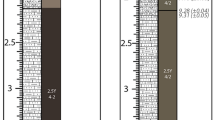Abstract.
Pollen and micropalaeontological analyses carried out on mangrove swamp sediments of Suwayh, Oman (22°05.589'N, 50°40.033'E) reveal environmental changes linked both to climate (monsoon) and geomorphological (sea-level) variations during the Late Holocene. A Rhizophora mangrove developed at Suwayh around 6000 years B. P. under climate conditions marked by an increased tropical influence as compared to the modern situation, with dominant summer rains. The later extension of Prosopis cineraria at Suwayh provides evidence for a different rainfall pattern, with a winter rainy season. Pollen and micropalaeontological composition shows three episodes influenced by the sea water at Suwayh. The most important corresponded to the mangrove episode centred ca 6000 B. P. This was followed by two episodes of slight seawater incursion at ca. 5100 and 4500 B. P. responsible for the formation of a brackish laagon. Comparison based on 14C measurements on shell recovered from both the sedimentary sequence of Suwayh and the nearby archaeological sites demonstrates that close relations existed between man and mangroves during the Neolithic and the Early Bronze Age.
Similar content being viewed by others
Author information
Authors and Affiliations
Additional information
Received October 31, 2001 / Accepted January 24, 2002
Correspondence to: Anne-Marie Lézine
Rights and permissions
About this article
Cite this article
Lézine, AM., Saliège, JF., Mathieu, R. et al. Mangroves of Oman during the late Holocene; climatic implications and impact on human settlements. Veget Hist Archaeobot 11, 221–232 (2002). https://doi.org/10.1007/s003340200025
Issue Date:
DOI: https://doi.org/10.1007/s003340200025




